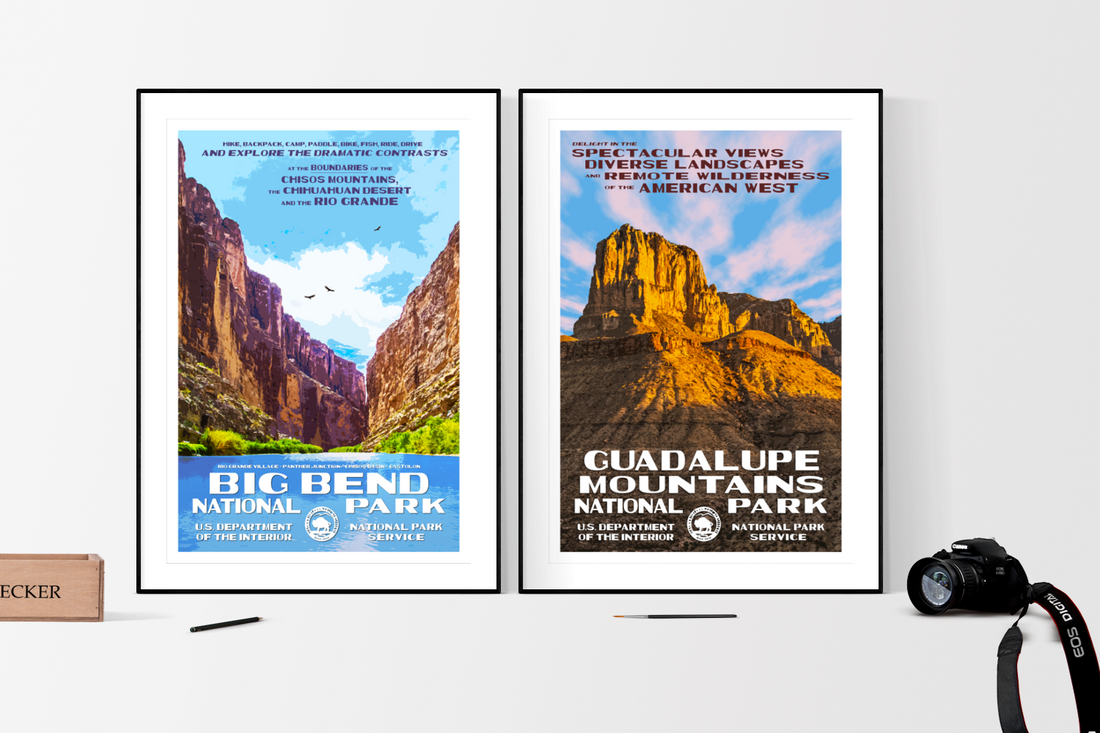Big Bend National Park
Big Bend National Park is located in a remote part of Southern Texas and borders Mexico along the Rio Grande. It has national significance as the largest protected area of Chihuahuan Desert topography and ecology in the United States. It contains more than 1,200 species of plants, more than 450 species of birds, 56 species of reptiles, and 75 species of mammals. The Rio Grande corridor is also a migration highway for many species passing through the desert. Elevation contrast create varied microclimates that further enhance the diversity of plant and animal life.
 Click here to see the Big Bend National Park poster.
Click here to see the Big Bend National Park poster.
The national park covers 801,163 acres and is home to an abundant variety of Cretaceous and Cenozoic fossil organisms, and the park has artifacts estimated to be 9,000 years old. Historic buildings and landscapes offer graphic illustration of life along the international border in the 19th century.
For more than 1,000 miles, the Rio Grande/Río Bravo forms the boundary between Mexico and the United States, and Big Bend National Park administers approximately 118 miles along that boundary. The park was named after a large bend in the river and Texas—Mexico border. One of the park's best known features is Santa Elena Canyon. Split by the Rio Grande, on one side, the United States; the other, Mexico.
Because the Rio Grande serves as an international boundary, the park faces unusual constraints while administering and enforcing park rules, regulations, and policies. In accordance with the Treaty of Guadalupe Hidalgo, the park's territory extends only to the center of the deepest river channel as the river flowed in 1848. The rest of the land south of that channel, and the river, lies within Mexican territory. The park is bordered by the protected areas of Parque Nacional Cañon de Santa Elena and Maderas del Carmen in Mexico.
Guadalupe Mountains National Park
Guadalupe Mountains National Park is situated in the Guadalupe Mountains of West Texas and preserves the rugged spirit and remote wilderness of the American West. Guadalupe Peak, the highest point in Texas at 8,749 feet and El Capitan, were long used as a landmark by the Butterfield Overland Mail stagecoach line. The Guadalupe Peak Trail offers perhaps the most outstanding views in the park. Climbing over 3,000 feet to the summit of Guadalupe Peak, the trail winds through pinyon pine and Douglas-fir forests and offers spectacular views of El Capitan and the vast Chihuahuan Desert.
 Click here to see the Guadalupe Mountains National Park poster.
Click here to see the Guadalupe Mountains National Park poster.
The park covers 86,367 acres and is in the same mountain range as Carlsbad Caverns National Park which is located about 25 miles to the north in New Mexico. The Guadalupe Mountains are among the best examples of a marine fossil reef, which formed 260-270 million years ago. Eventually, the sea evaporated and as the reef subsided it was entombed for millions of years until a mountain-building uplift exposed part of it.
Numerous well-established trails exist in the park for hiking and horse-riding. Visitors can see the ruins of an old stagecoach station near the Pine Springs Visitor Center. Camping is available at the Pine Springs Campground and Dog Canyon. The restored Frijole Ranch House is now a small museum of local ranching history and is the trailhead for Smith Spring. The park also contains McKittrick Canyon. A trail in the canyon leads to a stone cabin built in the early 1930s, formerly the vacation home of Wallace Pratt, a petroleum geologist who donated the land in order to establish the park.
Rob Decker is a photographer and graphic artist who had the rare privilege of studying under Ansel Adams in Yosemite National Park when he was just 19 years old. Now, Rob is on a journey to explore and photograph all of America’s National Parks. He’s creating WPA-style posters to help people celebrate their own national park adventures — as well as encourage others to get out and explore!
Click here to learn more about the artist, Rob Decker...
Join the growing community of 80k+ National Park enthusiasts to receive insider deals and updates.

